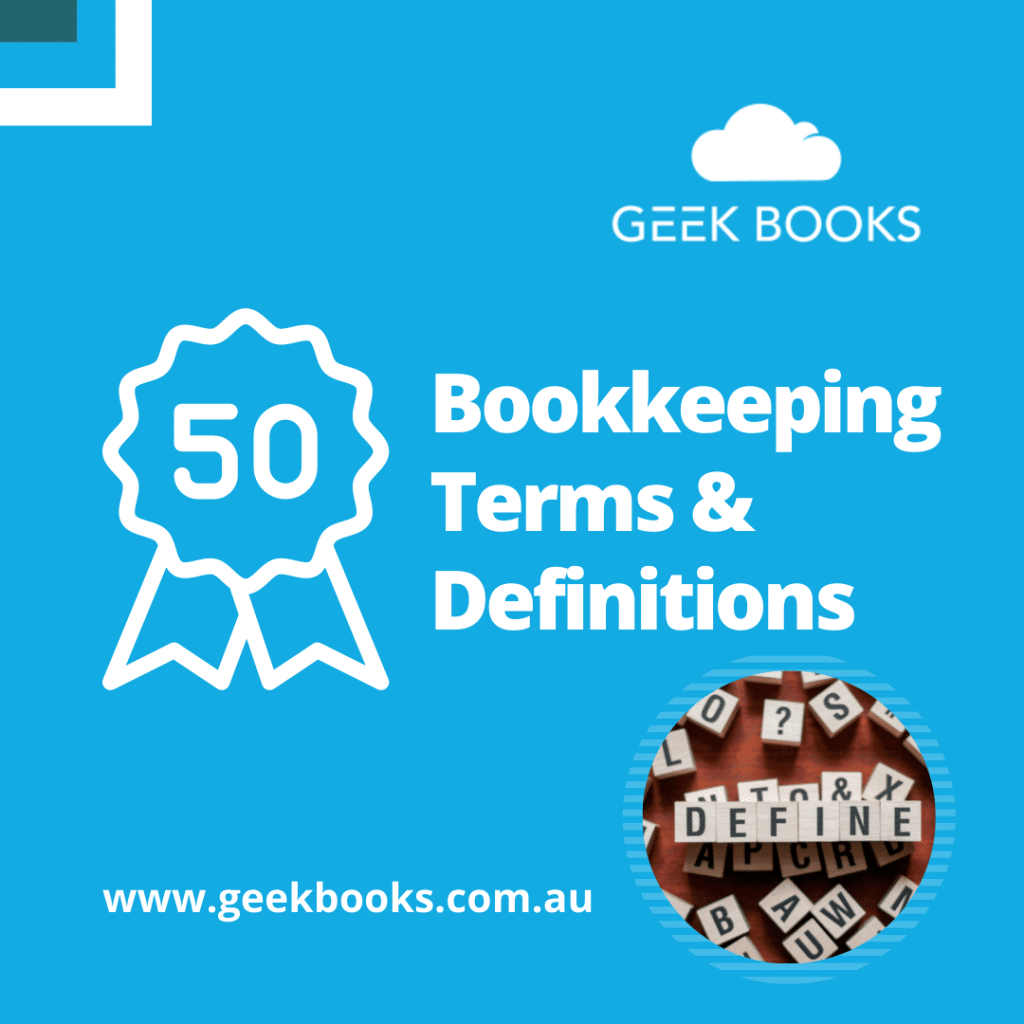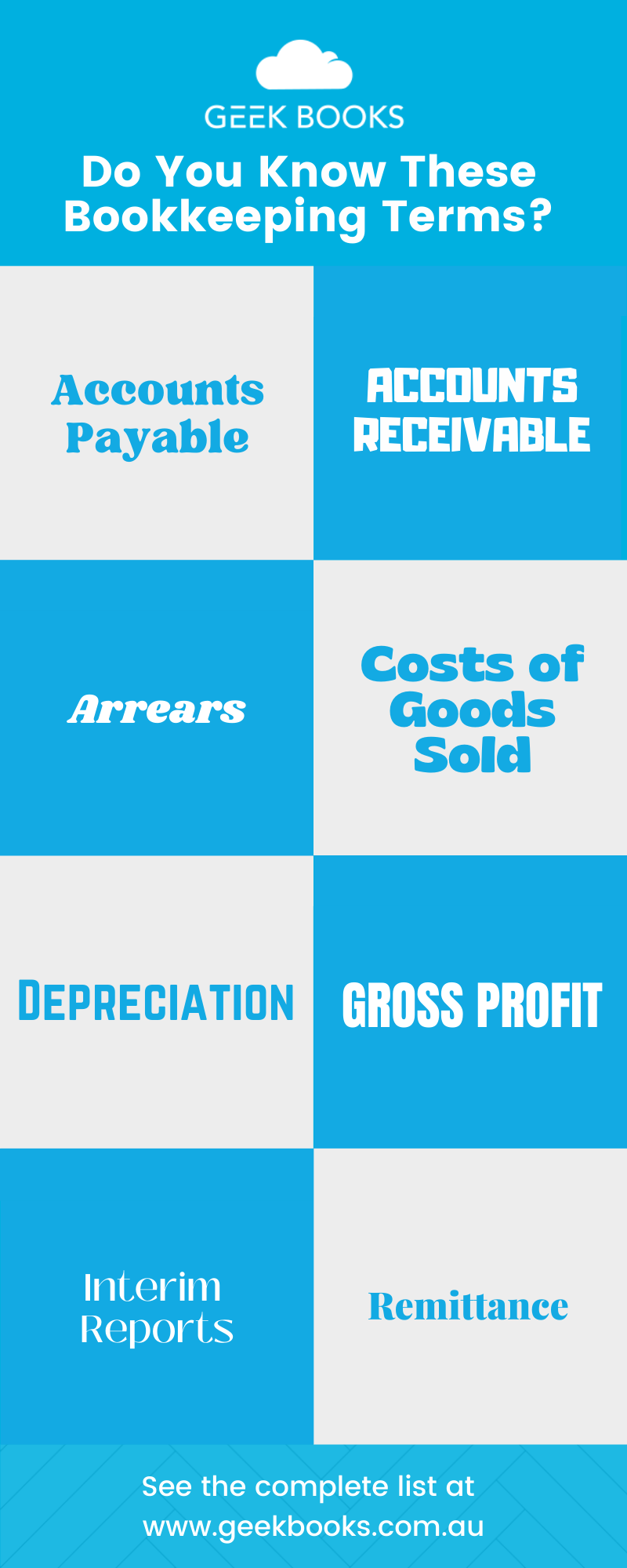If you don’t have a background in accounting, a lot of the bookkeeping jargon and accounting terminology might be somewhat confusing.
For example, you may think you know what ‘accounts’ means, but the definition is very specific in bookkeeping, and concepts like ‘remittance’ and ‘reconciliation’ might go straight over your head.
These bookkeeping terms often have small business owners spending time researching just to understand what data goes where.
It’s an extra headache you don’t need while carrying out an already complex and stressful process.
But by gaining a basic understanding of what these terms mean, and the difference between bookkeeping vs accounting, you could go into your bookkeeping work ready to tackle everything it involves. For a run-down of the daily responsibilities of a bookkeeper, see our bookkeeper duties checklist.
In this article, we present 50 bookkeeping terms and definitions to break down the jargon into plain English for you.
This bookkeeping glossary should be helpful if you are trying to carry out your own bookkeeping process so that you can do the work confidently.

Bookkeeping Glossary: 50 Terms You NEED To Know
Bookkeeping is a fundamental process that all businesses must carry out one way or another.
It tracks all transactions to keep an up-to-date record of the company’s finances, providing the basis for all the work your accountant will do for tax filing and analysing business performance.
You will benefit by considering what is bookkeeping and reading the Geekbooks bookkeeping guide to get you on the front foot.
GeekBooks can handle your bookkeeping for you with our menu of services, but if you are tackling it yourself then this resource is for you. Here are the 50 bookkeeping terms you need to know:
Accounting Period
This is the length of time taken to complete an accounting cycle. During this time, you record business transactions to produce financial statements. An accounting period typically lasts one year, finishing with you reconciling everything into formal statements and paying your tax.
Accounts Payable
This refers to any outstanding money you owe to vendors and suppliers. These are the short-term bills that have already been charged but are yet to be paid. The accounts payable are recorded on your balance sheet, and it is classed as a liability since it is, essentially, debt.
Accounts Receivable
This is money you are yet to receive from customers for products or services (basically unpaid invoices). It still counts as money earned, since the customer is required to pay the bill. The amount owed is credited to your accounts receivable, then debited to your cash accounts once the customer pays.
Arrears
This is money your business is owed, or that your business owes, which has not been paid and is now overdue.
Assets
This refers to all tangible and intangible items that your business owns and that could be turned into cash. Assets could be vehicles, property, savings, etc. You include these on your balance sheet, and the total value of your assets should be reported.
Balance Sheet
This is a comparison between your assets owned, your equity and all your liabilities. It gives you a broad picture of how the financial health of your organisation should look. Balance sheets can be difficult to create, since the assets must equal your equities plus your liabilities. Double entry bookkeeping is the system of recording transactions as a balance of credits and debits across all affected accounts. The average small business owner may not track all these things, or have the time to dig into questions like what is double entry bookkeeping, which is one reason a bookkeeper can be so helpful.
Billing
This is the process of sending invoices to customers/clients that have purchased products or services from your business.
Bookkeeping
The broad definition of bookkeeping is that it is the process of creating and maintaining accurate records of the financial affairs of your company.
Budget
A budget is a financial plan that forecasts the amount a business is likely to earn, providing details of where money will be spent in the forthcoming year.
Capital
This is the amount of money that the business owner personally holds.
Cashflow
This is the movement of money into and out of your business – your income and expenses. The goal is to have positive cashflow. Many business owners procrastinate when it comes to ‘keeping the books’ as it is time-consuming and tedious, but this causes them to miss out on insights into their business. Maximise profitability by keeping on top of cashflow.
Chart of Accounts
This is simply the way you categorise your revenue and expense transactions. With a chart of accounts, your transactions are effectively categorised to produce a profit and loss statement.
Closing Balance
This is the positive/negative amount of money that remains in your account when you reach the end of the accounting period.
Costs of Goods Sold
Often abbreviated to COGS, this is the money you invest to create the product/service you sell to your customers. This qualifies as an expense, and is often the largest for your business, and is subtracted from your net sales to calculate gross profit.
Creditors
These are the entities your business owes money to.
Debtors
These are the entities that owe money to your business.
Deductible
These are expenses that can be legally claimed as business expenses. They lower your business profits but also your liability for tax.
Depreciation
This is the amount that the value of a fixed asset reduces over time. Accounting for depreciation is focused on calculating how much value will be lost over time.
Equity
This is the amount business owners and shareholders invest in the business from their personal fund, minus the amount they have withdrawn for personal use.
Expenses
These are the money you spend to keep your business running. They could be the cost of goods sold, office supplies, rent, payroll, etc. They go on your profit and loss statement to use for tax deductions, but you will need to include evidence to back up claims on tax forms.
Factoring
This is when you receive money straight away from a finance company without waiting for customers to make their payments.
Financial Statements
These are formal reports that show the performance of the business and its total value. They help calculate your tax liability. It’s worth noting that there are many different software packages available that provide free bookkeeping templates and accounts spreadsheets to help with bookkeeping for small businesses – such as cashbook templates, expense reports and balance sheets.
Gains and Losses
This refers to losses a business suffers through things like sale of assets, foreign currency transactions and other capital transactions.
Gross Profit
This is the final profit figure of a business. It is calculated by subtracting the direct cost of sales from the total revenue.
General Ledger
This is a comprehensive record of your business accounts, summarising all transactions in a journal. Bookkeeping involves creating and maintaining the general ledger, ensuring all transactions are accounted for and categorised by your chart of accounts.
Income Statement
This is another name for the profit and loss statement. It is a means of understanding the amount of money you made and the amount you spent. It communicates your profits and losses at the close of any given time period.
Interim Reports
These financial reports are produced before the end of the financial year to give business owners, loan companies and banks an idea of the company’s performance throughout the year.
Inventory
This is an account that tracks the number of products currently held that are going to be sold to customers.
Journals
In bookkeeping, this is another term for ‘account’. All daily business transactions are placed into journals, like the sales journal or the cash receipts journal, before being recorded in the general ledger. This is to ensure all transactions are accounted for and properly organised.
Liabilities
These are specific items like unpaid invoices or business loans. They usually go on your balance sheet against assets and equities, and are usually classified under ‘accounts payable’.
Loss
When your gross income is lower than the outgoing expenses, you have made a loss. Naturally, this is something you want to avoid where possible.
Margin
This is the difference between the cost it takes to produce/purchase goods and the amount they sell for. So, for example, if it costs £30 to produce an item, and you sell it for £70, the margin would be £40.
Net Profit
This is what you get when you subtract business expenses from your gross profit. It helps get a realistic idea of how well your business is performing.
Opening Balances
If you wish to transfer your accounts from one year to the next, or from one system to another, you must post the closing profits from one onto the opening balances of the next.
Overheads
These are ongoing business expenses that enable a company to operate day to day. It can include things like wages, rent, energy bills and more.
Payroll
This is a list of your company’s employees and the amount you pay each one. A smaller company, for example, may have 5 employees on its payroll, and they must calculate the compensation those employees are paid, including tax and pension contributions.
Petty Cash
This is a small quantity of cash that is retained to purchase everyday items like stationery, supplies, stamps, etc.
Profit and Loss
This is a formal financial report that shows revenue and expenses over a predetermined period of time.
Purchase Ledger
This is a record of company purchases and expenses. It shows a list of all invoices and the amount the business owes.
Reconciliation
Reconciliation is when you compare two sets of records to ensure they are identical. For example, you might compare the list of transactions against bank statements to ensure nothing has been missed.
Remittance
Sometimes, there is a sum of money that a business sends its customers for goods and services. The remittance is the document that is sent with it.
Retained Profits
This is money you keep in the business, as opposed to paying it out to owners and shareholders.
Revenue
This is the amount of money that comes into a business before any expenses are accounted for. It goes at the top of the profit and loss report.
Sales Ledger
All sales for every customer is recorded here, along with all the relevant details.
Subsistence
This is the money paid to cover business trip expenses, such as hotel bills and travel costs.
Turnover
This is the total value of goods or services that are sold over a specific period of time.
VAT
VAT stands fr Value Added Tax. All companies that are registered for VAT must add it to their sales invoices in order to claim back from purchases.
Write Off
Whenever debt from customers is no longer expected to be collected, it must be written off from the sales ledger.
Undeposited Funds
These are payments made in cash, by cheque, or by credit card that has not yet been deposited into the bank.
Year-End
This is the end of the financial year. At this time, all accounts need to be produced and submitted for reporting and tax purposes.
Summary
Bookkeeping jargon is something you need to familiarise yourself with if you are going to handle your bookkeeping yourself. You could also check out these bookkeeping tips from the experts.
There will be many occasions where the terms listed in this article come up, so it pays to have an understanding of the different bookkeeping terminology and concepts.
Even if you outsource to a professional bookkeeper, it can be helpful to understand these terms when communicating with them.
Naturally, if you partner with GeekBooks, we will always go out of our way to ensure you fully understand the records and reports we provide for you. But educating yourself on some of the basics can be useful as well.
Ultimately, your bookkeeping must ensure that all transactions are:
- Recorded accurately and legitimately
- Categorised appropriately and optimised for reporting
- Provided with the right documents attached
That is it in a nutshell. It becomes more complex when there are many transactions, but the basic concept remains the same.
You now have some basic explanations of the most popular bookkeeping terms. If you are thinking of hiring or outsourcing a bookkeeper, it’s worth doing some research to find out how much does a bookkeeper cost? There are various factors at play, but you should bear in mind that they are providing a specialist and essential service for your business.
If you feel you still need help with your bookkeeping, check out our guide to bookkeeping for beginners or contact GeekBooks today and tell us about your business.
Our helpful team will listen and answer your questions, and we will run you through our services if you are interested in working with us.



